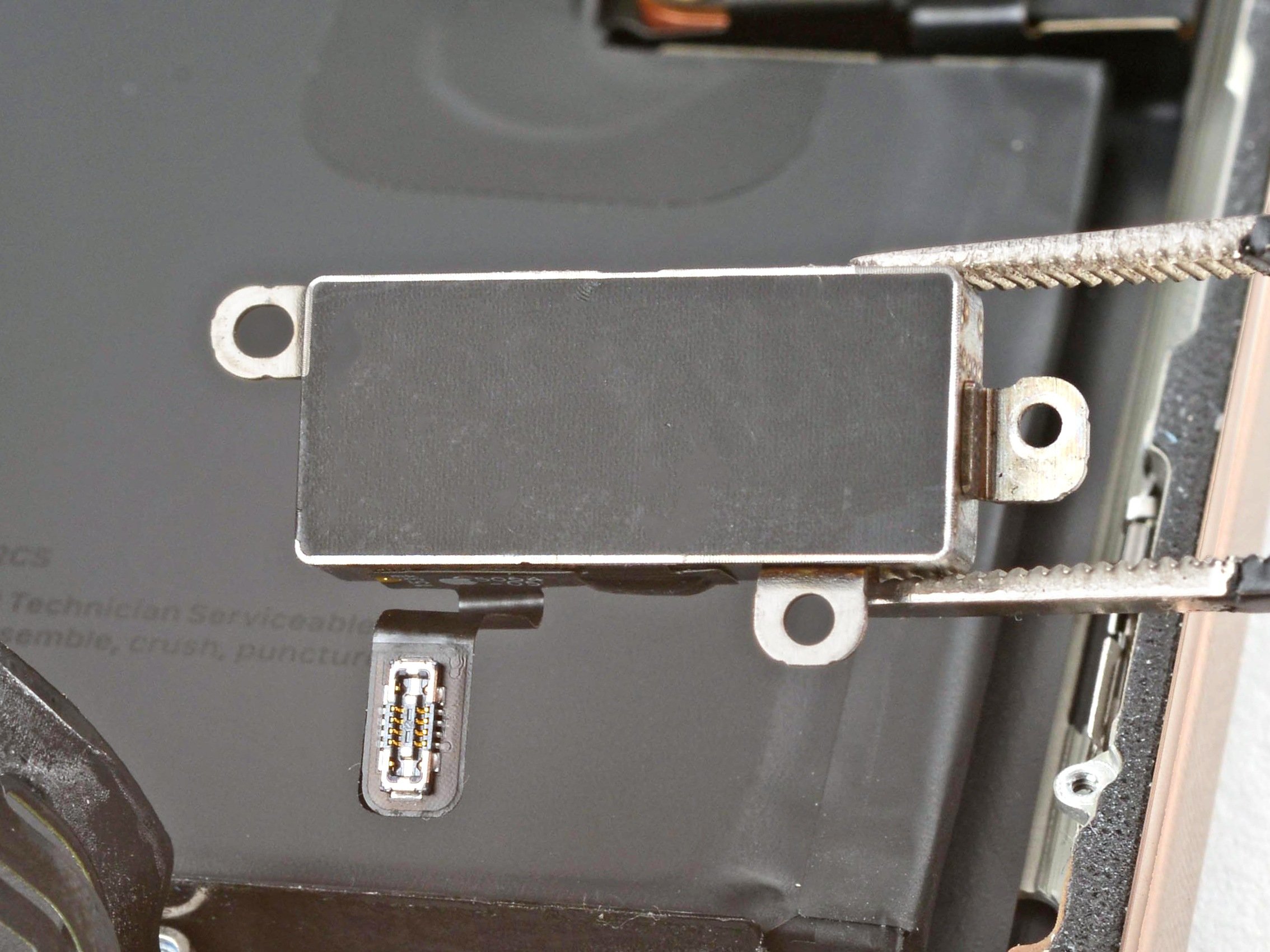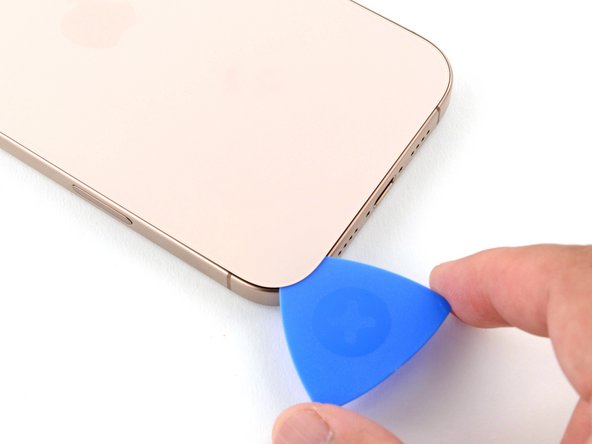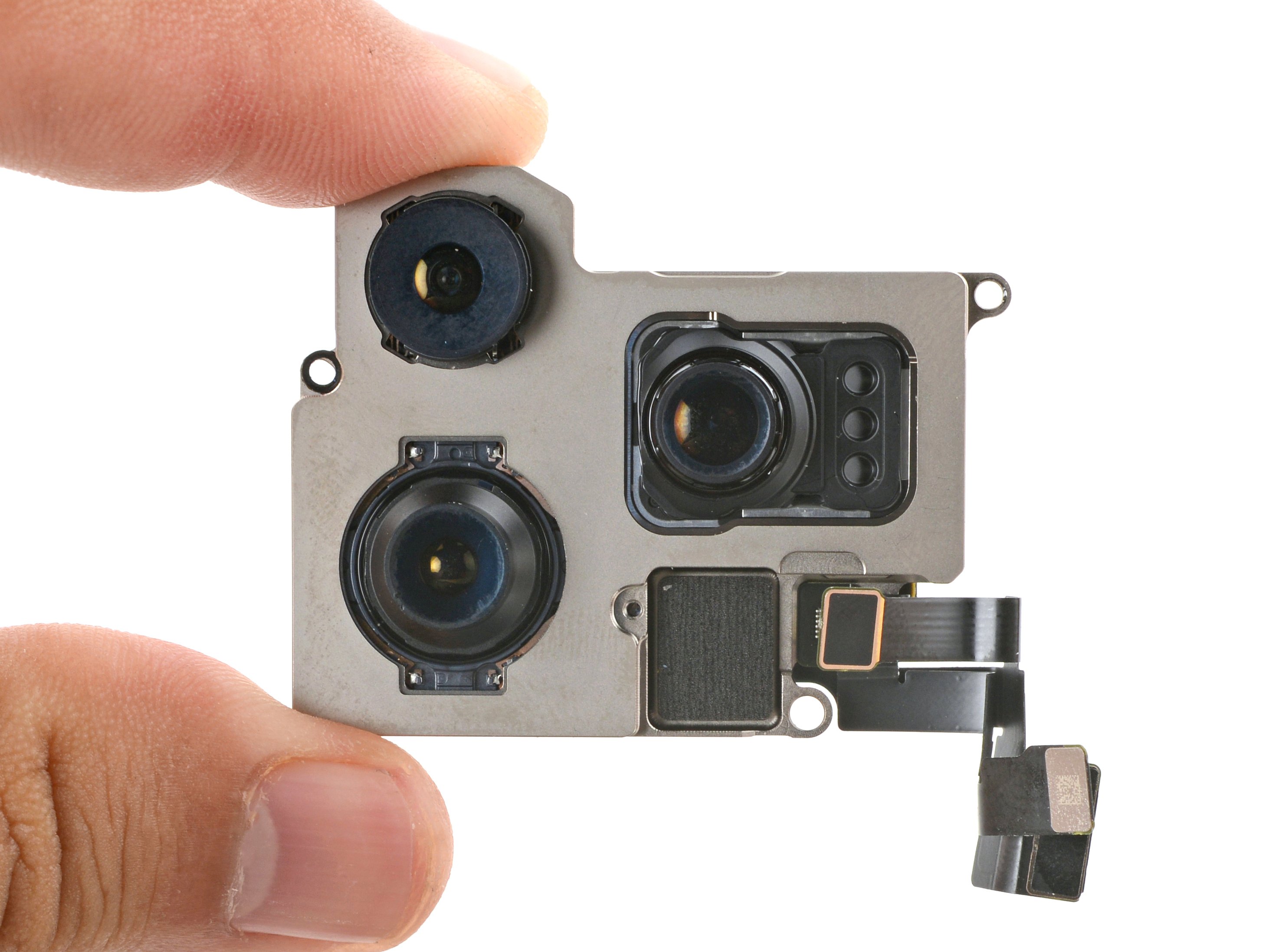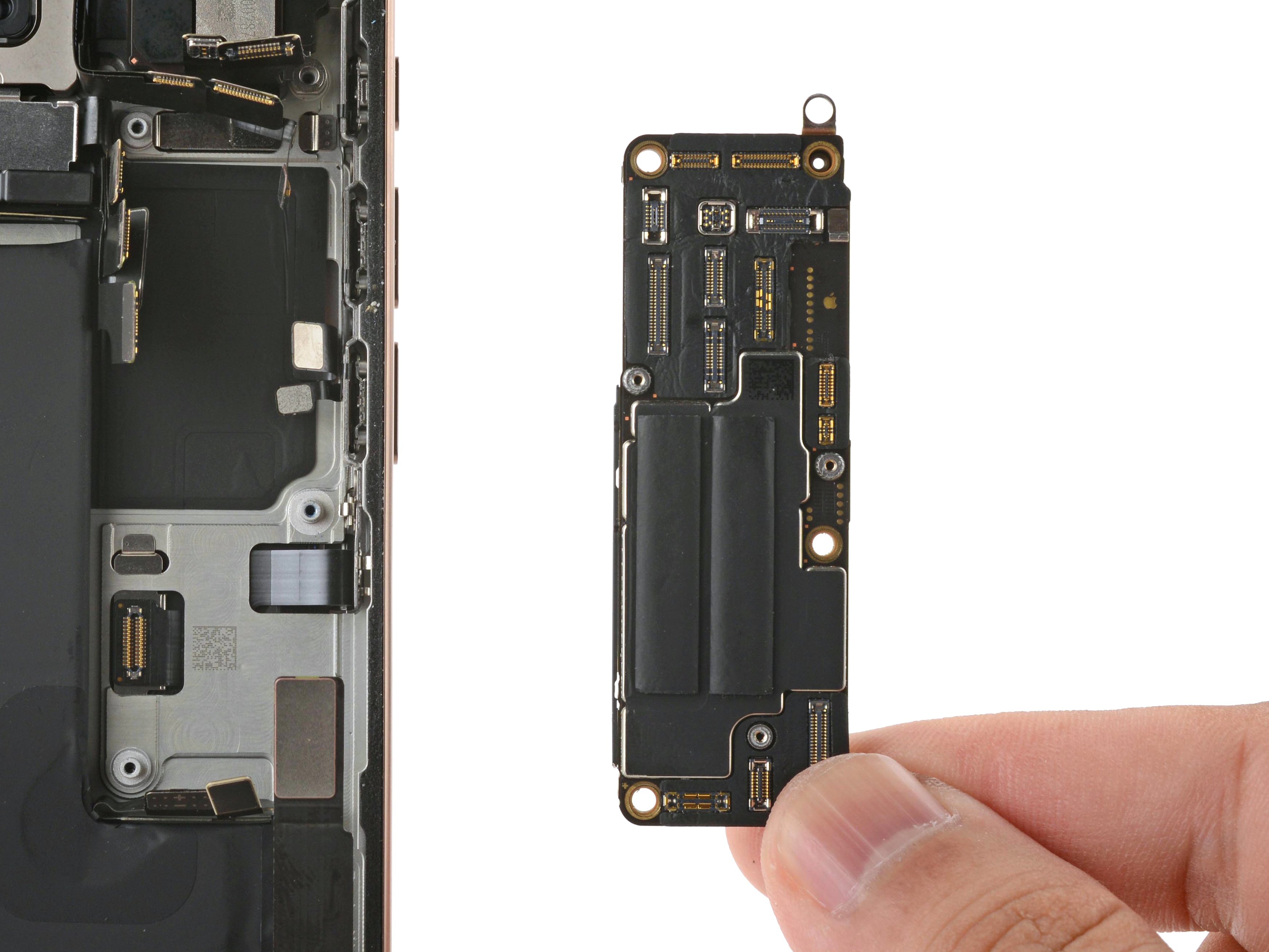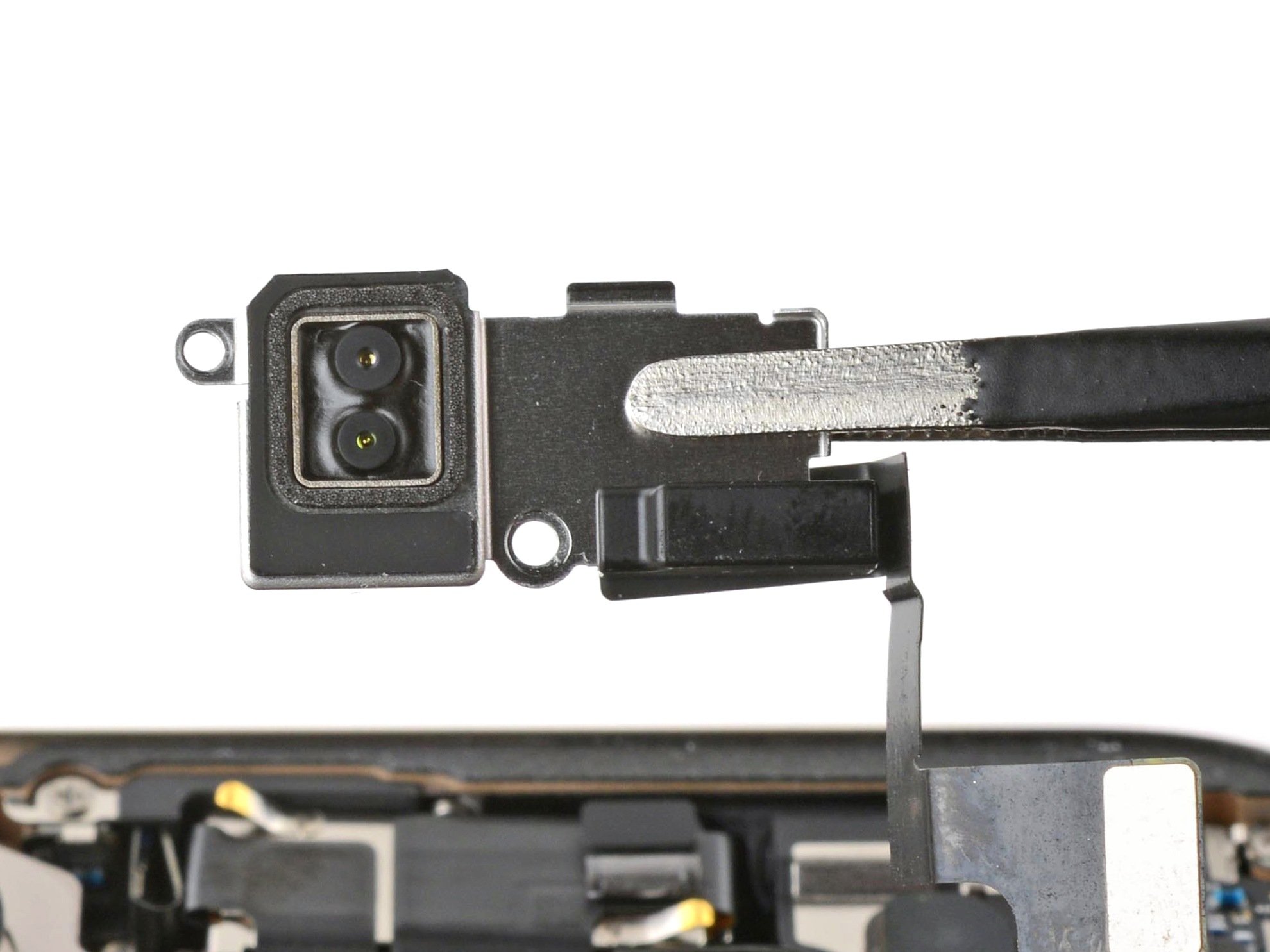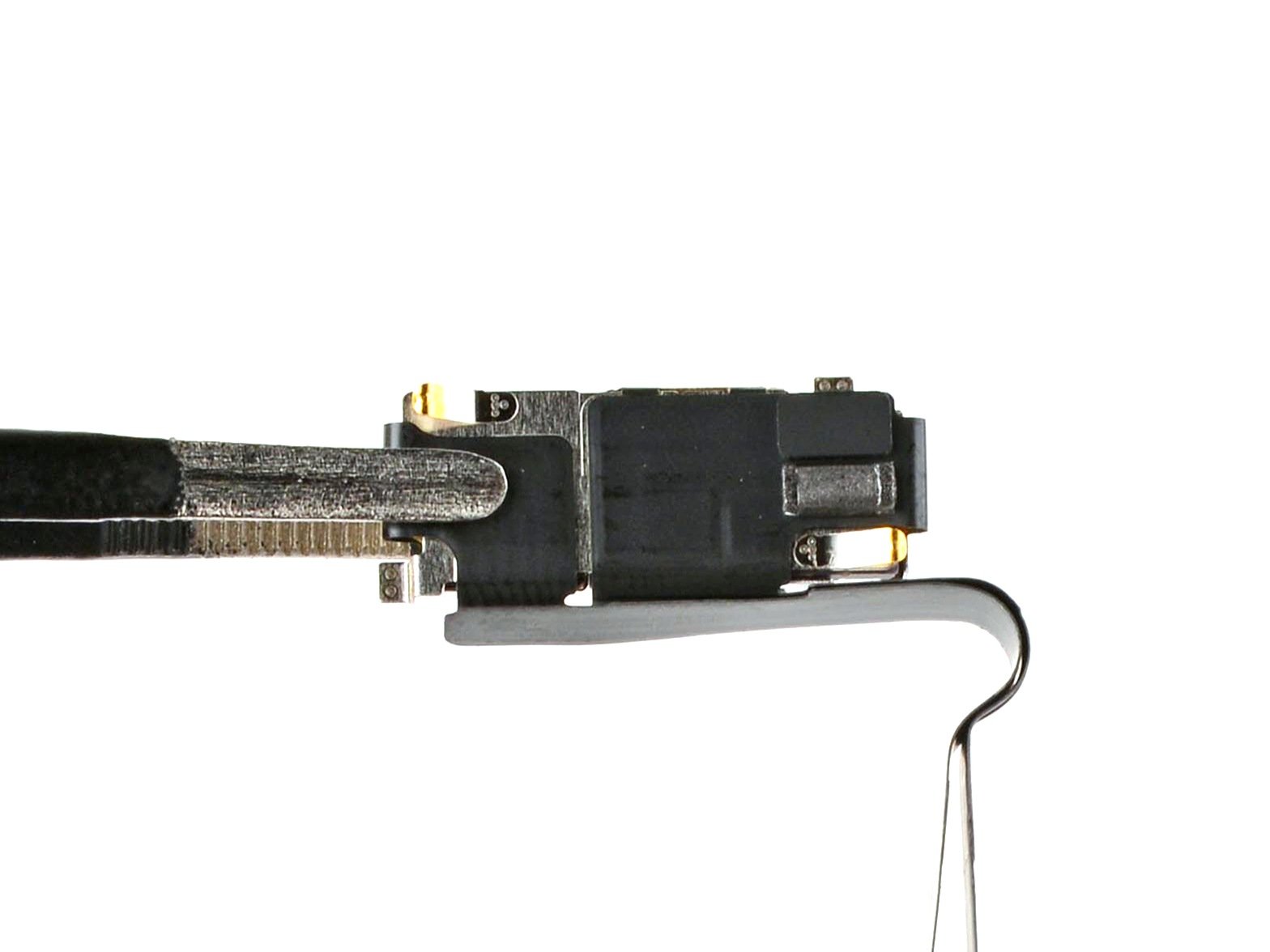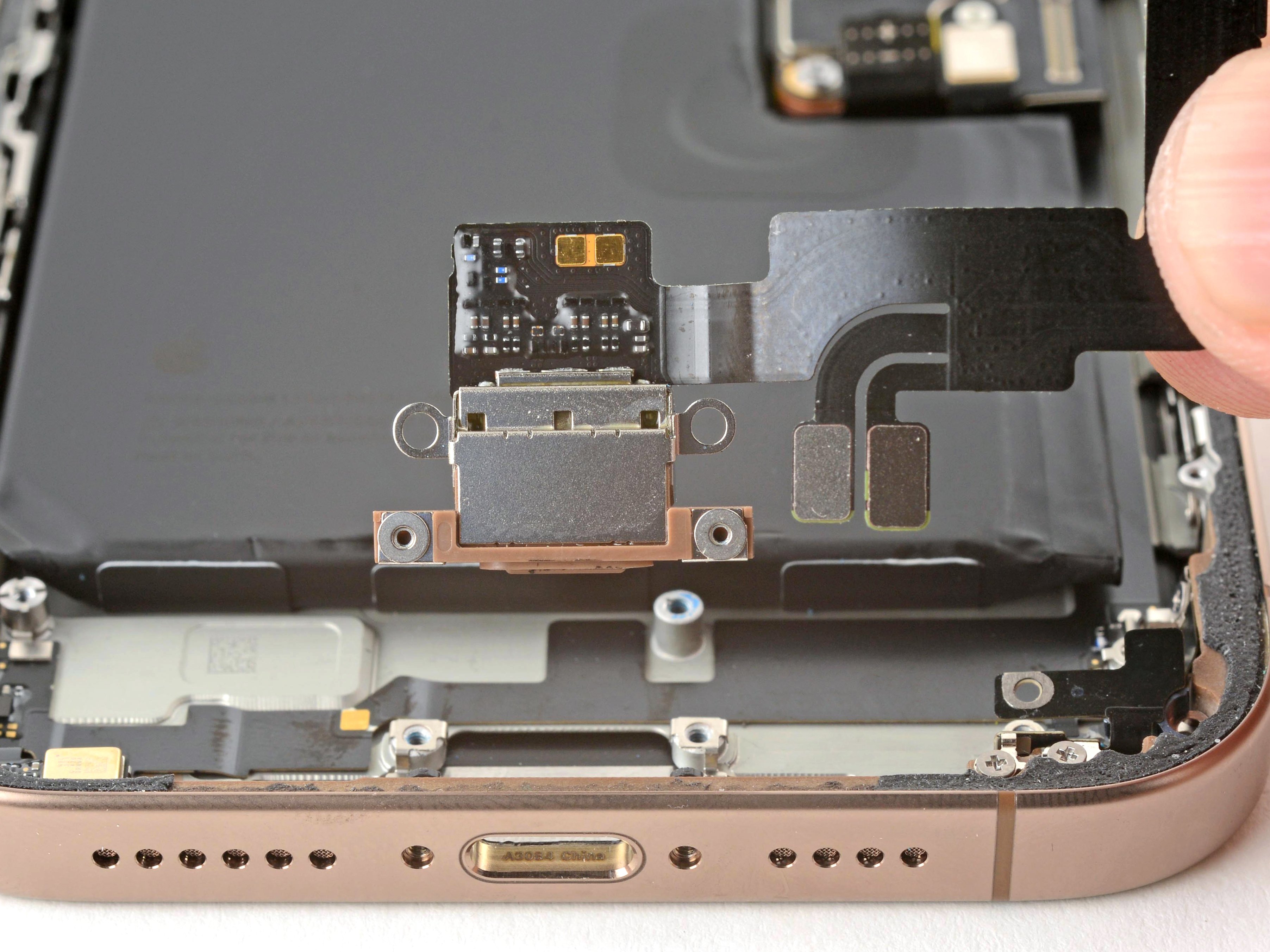iPhone 16 Pro Max Taptic Engine Replacement
Duration: 45 minutes
Steps: 66 Steps
Looking to get those satisfying haptic taps back on your iPhone 16 Pro Max? This guide walks you through removing and swapping out the Taptic Engine. If your phone's vibrations are feeling weak or have gone silent, a fresh Taptic Engine might do the trick. Don't forget, you'll need some replacement back glass adhesive to seal the deal. Ready to bring those buzzes back? Let’s get started—if you need help, you can always schedule a repair.
Step 1
Let your iPhone’s battery dip below 25% before starting — a fully charged lithium-ion battery can be a bit of a wild card!
- Disconnect any cables plugged into your iPhone.
- Press and hold the power button along with either volume button, then slide to turn off your iPhone.
Step 2
Find a nice, smooth spot along the bottom edge that’s just right for a suction cup to grip onto.
- If your screen or back glass is seriously cracked, slap some overlapping strips of packing tape over it. This keeps you safe from shards and makes taking it apart a whole lot smoother.
Tools Used
Step 3
- Grab your P2 pentalobe screwdriver and unscrew the two 7.4 mm screws on each side of the charge port. If you run into trouble or need a hand, you can always schedule a repair for expert assistance.
Step 4
Be careful not to shove that opening pick in too deep; we wouldn't want to hurt your device! A little marking goes a long way in keeping things safe.
Feel free to add some flair by marking the other corners of your pick with unique measurements.
If you're feeling crafty, try taping a coin to a pick about 3 mm from the tip for a nifty measuring guide.
- Grab your marker and mark a spot 3mm from the tip of the opening pick—easy peasy! If you need help, you can always schedule a repair.
Tools Used
Step 5
The next couple of steps guide you through gently creating a starting point with a suction handle. Alternatively, you can use an iOpener to warm up the back glass. Just follow these tips to heat and apply the iOpener smoothly and safely. If you need help, you can always schedule a repair.
- Grab a hair dryer or heat gun and gently warm up the bottom edge of the back glass until it feels comfortably warm to the touch. This will help loosen things up for the next step.
Tools Used
Step 6
If the gap isn’t showing up, give it some more heat to loosen things up and try again. Keep at it—patience is key for a smooth fix. If you need a hand, you can always schedule a repair.
- Stick a suction cup onto the bottom edge of the back glass to get a grip.
- Give it a firm, steady pull to loosen the back glass from the frame.
- Carefully slide an opening pick into the gap to start lifting it away.
Tools Used
Step 7
When you’re slicing through the adhesive holding the back glass, keep your pick shallow—no deeper than 3 mm—to avoid poking into sensitive spots below.
- There's a fragile cable running from the back glass to the iPhone, tucked right next to the volume up button. Keep your pick away from this spot to avoid cutting it.
- Around the edge of the iPhone, you'll find several spring contacts buzzing with energy.
Step 8
If the adhesive is being stubborn and hard to cut through, warm up the edge for about a minute and give it another shot.
- Gently slide your opening pick along the bottom edge to cut through the adhesive holding the device together.
- Keep the opening pick in the bottom-left corner to prevent the adhesive from sticking back together as you work.
Step 9
- Grab a hair dryer or heat gun and warm up the left edge of the back glass until it feels nice and toasty to the touch.
Tools Used
Step 10
Be gentle! Don't insert your pick more than 3 mm deep—that's the sweet spot to avoid messing with those spring contacts. Keep it light and steady for the best results. If you need help, you can always schedule a repair.
As you glide through, you'll hear and feel those metal clips giving way – it's like music to your ears!
- Pop in a second opening pick at the bottom-left corner, right next to your first pick.
- Gently glide your pick along the left edge to break that stubborn adhesive and set those metal clips free.
- Keep this pick snugly in the top-left corner to stop the adhesive from getting all clingy again.
Step 11
- Grab your trusty hair dryer or heat gun and gently warm up the top edge and top-right corner of the back glass until it feels nice and toasty!
Tools Used
Step 12
Keep your pick within 3 mm to steer clear of those pesky spring contacts. You're doing great!
- Pop a third opening pick into the top-left corner like a pro.
- Gently slide that pick along the top edge and curve it around the top-right corner, stopping just above the volume up button.
- Keep this pick in place to stop the adhesive from snapping back together.
Step 13
- Grab a hair dryer or heat gun and warm up the right edge of the back glass until it feels nice and toasty to the touch.
Tools Used
Step 14
Be gentle with your pick—don’t go deeper than 3 mm to keep those spring contacts happy and intact.
- Grab a fourth pick and gently slide it into the bottom-right corner to get things started.
- Carefully work the pick around the corner and up the right edge, stopping just below the volume down button for a smooth entry.
- Keep this pick in place to stop the adhesive from sealing back up as you work—staying one step ahead makes the job easier.
Step 15
By now, the back glass should pop right off the frame. If it’s being stubborn, take your pick and gently run it around the edges again to spot any clingy adhesive or sneaky clips holding on tight.
- Gently flip open the back glass on the right side of the iPhone to loosen up the remaining adhesive.
- Keep the back glass steady by supporting it with a clean, sturdy object—no wobbles allowed!
Step 16
- Grab your tri-point Y000 screwdriver and gently unscrew the three screws holding down the battery connector cover. You'll find two screws measuring 1.3 mm in length and one tiny 1.0 mm screw. Keep track of all these little fasteners—they're essential for reassembly. If you need a hand, you can always schedule a repair and let the pros handle it.
Step 17
- Gently lift off the battery connector cover to expose the inner components. If you need a hand, you can always schedule a repair for expert assistance.
Step 18
- Grab your spudger and carefully pry up the battery press connector to disconnect it. Take your time—patience is key to a smooth repair. If you need a hand, you can always schedule a repair.
Tools Used
Step 19
- Grab your trusty tri-point Y000 screwdriver and carefully unscrew the four screws holding down the back glass connector cover:
- Two screws are 1.3 mm long
- Two screws are 1.0 mm long
Step 20
- Carefully lift the back glass connector cover straight up to remove it. If you need help, you can always schedule a repair.
Step 21
- Gently use the tip of a spudger to lift and disconnect the back glass connector. Take it slow and steady, you've got this!
Tools Used
Step 22
- Carefully lift off the back glass panel to get started. Remember, patience is key—take your time to avoid any cracks or chips. If you need a hand during the process, you can always schedule a repair for expert assistance.
Step 23
- Grab your Phillips screwdriver and loosen those three screws holding down the Taptic Engine cover: the 2.9 mm-long screw, the 1.3 mm-long screw, and the 2.4 mm-long screw. Keep them safe—you'll need them later. If you need help, you can always schedule a repair.
Step 24
- Grab those tweezers or just use your fingers to gently lift the top edge of the Taptic Engine cover. You're on the right track!
- Once you hear that satisfying little 'pop' from the bottom edge as it frees itself from the frame, go ahead and take off the Taptic Engine cover. You're doing great!
Tools Used
Step 25
- Gently wiggle the pointy end of your spudger under the lower assembly cable and lift it off the logic board like a pro.
Tools Used
Step 26
- Grab your spudger and gently slide the point under the connectors near the bottom right corner of the frame. Pry them up with a little care, and you'll have them disconnected in no time!
Tools Used
Step 27
- Let's get those cables loose! First, you'll want to remove the two screws holding the lower assembly cable in place:
- One 1.0mm-long tri-point Y000 screw. It's small but mighty!
- And don't forget the 1.3mm-long Phillips screw. Nice and steady!
Step 28
- Grab your trusty hair dryer and give that lower assembly cable section above the Taptic Engine a warm hug until it’s nice and toasty to the touch!
Tools Used
Step 29
- Gently slide an opening pick under the lower assembly cable to pop it loose from the Taptic Engine.
- Carefully nudge the cable aside so you have clear access to the Taptic Engine.
Step 30
- Grab your Phillips screwdriver and remove the tiny 2.1 mm screw holding the Taptic Engine in place. Keep it safe—you'll need it later. If you need a hand, you can always schedule a repair with Salvation Repair.
Step 31
- Grab your spudger and gently pry up the corner bracket—it's as easy as pivoting it free. Keep it smooth and steady, and you'll have that part lifted in no time. If you need a hand, don’t hesitate to schedule a repair with Salvation Repair.
Tools Used
Step 32
- Gently slide the tip of an opening pick along the top edge of the Taptic Engine to carefully peel away the plastic buffer strip stuck to it.
Step 33
Be gentle around the battery—no prying or poking, or you might cause trouble. Take your time and handle with care!
- Gently slide the spudger's tip underneath the Taptic Engine and give it a little lift.
- Carefully take out the Taptic Engine.
Tools Used
Step 34
Great job finishing the disassembly! Now, let's walk through the reassembly steps to put your iPhone back together. Keep in mind, some photos might look a little different depending on your specific iPhone model, but rest assured, the process is the same. If you get stuck or need a hand, you can always schedule a repair with Salvation Repair for extra help.
Step 35
- Gently place the Taptic Engine into its designated spot, making sure it sits securely in its home.
Step 36
- Gently pivot the corner bracket down into its slot with your finger, making sure it clicks into place. Keep it steady and don't force it—patience is key. If you need a hand, you can always schedule a repair.
Step 37
- Grab your Phillips screwdriver and install the 2.1mm screw to lock the Taptic Engine in place. Just make sure it's nice and snug!
Step 38
- Gently apply pressure with your finger to snugly fit the lower assembly cable onto the top of the Taptic Engine.
Step 39
- Secure the lower assembly cable with two screws: a 1.0 mm tri-point Y000 screw and a 1.3 mm Phillips screw. Keep at it—these little guys hold things in place, so tighten them up properly. If you need help, you can always schedule a repair.
Step 40
- Gently use your finger or a spudger to press and snap the two lower assembly cable connectors together, like a perfect little tech hug.
Tools Used
Step 41
- Place the Taptic Engine cover gently into position, lining up the screw holes like a pro.
- Double-check that the bottom edge of the cover snaps snugly into the frame for a perfect fit.
Step 42
- Grab your Phillips screwdriver and get ready to remove the three screws holding down the Taptic Engine cover: one 2.9 mm‑long screw, one 1.3 mm‑long screw, and one 2.4 mm‑long screw. Keep track of each screw so you can put everything back in order. If you need a hand, you can always schedule a repair to get expert help.
Step 43
- Gently press the assembly cable connector onto the logic board using your finger or a spudger—think of it as giving it a little nudge to stay put. If you get stuck or need a hand, you can always schedule a repair for extra help.
Tools Used
Step 44
Be mindful of those delicate grounding clips while you're sprucing up the frame. If one decides to go rogue and bend out of shape, just give it a gentle nudge back into position with your fingers or some tweezers. You've got this!
- Grab some blunt-nose tweezers or use your fingers to gently peel off the bigger bits of adhesive around the frame's edge.
- Now, take a spudger and carefully scrape away any leftover sticky residue from the frame.
- If the adhesive is being stubborn, a little heat from a hair dryer or heat gun should do the trick—give it another try once it's nice and warm.
Tools Used
Step 45
- If you’re planning to reuse your back glass, grab a microfiber or lint-free cloth, add a few drops of high-strength isopropyl alcohol (90%+), and give the edges a good wipe to get the surface ready for fresh adhesive.
Step 46
Take your time with this step. A tidy, debris-free frame helps the replacement adhesive spread out smoothly, making sure everything sticks properly. Rushing can lead to misalignment or weak bonds, so patience pays off for a solid repair. If you need help, you can always schedule a repair.
- Grab a lint-free cloth or a coffee filter, and carefully wrap it around the spudger tip. Add a couple of drops of high-concentration isopropyl alcohol (over 90%)—the more, the merrier!
- Gently wipe along the edge of the frame, moving in one direction to remove any stubborn adhesive leftovers. Keep it smooth and steady!
Tools Used
Step 47
Take a good look at those little details, like the camera cutout and notches along the top and bottom edges. They'll help you picture how the adhesive will sit inside the frame. It's all about getting that perfect fit!
- Place the adhesive sheet onto the frame to check that it’s lined up just right.
Step 48
The adhesive is super sticky, so keep it away from anything until you're ready to stick it to the frame. No accidental messes!
Peel off the liner that reveals the sticky side designed to attach to the frame, especially if your adhesive has multiple layers. You got this!
- Take hold of the little tab in the corner of the adhesive sheet and gently peel back the liner to reveal a third of the sticky goodness. Get ready to stick it to the repair!
Step 49
Once you stick that adhesive down, it’s there for good! If it’s not quite right, you'll need to remove it and start fresh with some new adhesive.
- Line up the adhesive strip's edge with the iPhone's frame like you're making the perfect match. It should sit nice and easy.
- Once everything's lined up just right, press that adhesive strip onto the frame gently, like you're giving it a little hug.
Step 50
No adhesive strips? No worries! You can temporarily put your iPhone back together and keep using it, but remember, the water resistance won’t be as strong until you replace the adhesive.
Got the adhesive aligned? Awesome! The edges should snap right into place without any drama.
Slight misalignment? No big deal. Just gently nudge the long edges to line up with the frame.
Uh-oh, creases or wrinkles in the adhesive? It’s okay—just peel it off and start fresh with a new one.
- Keep peeling off the liner from the adhesive, gently pressing it down as you go to ensure it sticks smoothly. Take your time—no rush, and you'll have that adhesive perfectly in place in no time. If you need a hand, you can always schedule a repair.
Step 51
Be careful around those delicate grounding clips! If one goes a little rogue, just coax it back into shape with your fingers or some tweezers. You've got this!
Take it easy—pressing too hard will stretch and mess up the adhesive. Keep it chill!
- Grab a spudger and gently work your way around the entire edge of the iPhone, pressing down on the adhesive to loosen it up. If you need a hand, you can always schedule a repair.
Step 52
You might still see some little liners covering the edges—that's to keep the adhesive from sticking to anything during reassembly. No need to peel them off just yet; leave them in place until you're ready to stick everything back together.
- Grab a spudger or just use your fingers to gently lift the pull tab that's attached to the large front liner. You'll usually find it tucked away in one of the corners.
- Once you've got a good grip on the pull tab, just peel the large front liner off. It should come away from the adhesive without much fuss.
Tools Used
Step 53
- Gently prop up the back glass along the right edge of your iPhone to get started. Keep it steady as you work through the next steps. If you need help, you can always schedule a repair.
Step 54
- Grab your finger or the flat end of a spudger and gently press the back glass connector into place on the logic board. Keep it steady and make sure it clicks in properly. If you need help, you can always schedule a repair.
Tools Used
Step 55
Now's a smart moment to power up your iPhone and check that everything's running smoothly before sealing it back up. Once confirmed, power it down and keep putting it back together.
If your iPhone refuses to wake up, try plugging it into a charger and give it another shot.
Swapped out the logic board but the screen stays dark? Follow the screen guide to manually reconnect the display cable and get that display shining again.
- Give that battery press connector a little love tap with your finger or a spudger to snugly connect it to the logic board. You've got this!
Tools Used
Step 56
- Line up the back glass connector cover with its screw holes and gently lay it in place. Keep it aligned, and you're good to go. If you need help, you can always schedule a repair.
Step 57
- Grab your trusty tri-point Y000 driver and get ready to secure the back glass connector cover with these four screws:
- Two screws that are 1.3mm long
- Two screws that are 1.0mm long
Step 58
- Carefully line up the battery connector cover with its screw holes and gently place it down.
Step 59
- Grab your trusty tri-point Y000 driver and let's get those screws out of the way! You'll need to secure the battery connector cover with three little screws:
- Two of these tiny superheroes are 1.3 mm long, ready to hold things down.
- And don't forget the special one—it's 1.0 mm long, just hanging out waiting for its turn.
Step 60
As you peel away those liners, be careful not to let anything come into contact with the sticky adhesive. Keep it clean and smooth for the best results!
- Gently use your fingers or a spudger to peel off the perimeter liners, revealing the adhesive underneath. Take it slow and steady.
- Inspect the frame and back glass for any lingering liners. If you find any, remove them. There shouldn’t be any left behind!
Tools Used
Step 61
If you feel a little resistance, it might be that a perimeter clip has gotten a bit out of shape and is being pinched by the frame. Just take a look at where it's sticking, and gently nudge any bent clips back into place.
- Start by gently lowering the back glass onto the frame, beginning with the top edge. Make sure it aligns just right.
- Press down along the edges to ensure the back glass fits perfectly flush against the frame. A little pressure goes a long way!
Step 62
Warming things up helps the sticky stuff get all soft and cozy, making it easier to stick together like best buds.
- Grab your trusty hair dryer, heat gun, or iOpener, and warm up the back glass perimeter just enough that it’s too hot to touch comfortably. You don’t want it to burn you, but a little heat goes a long way!
Tools Used
Step 63
- Grab the sides of your iPhone and give it a good, steady squeeze all around the edge to loosen things up. If you need a hand, you can always schedule a repair.
Step 64
If you're looking for a different way to set the new adhesive, try wrapping some vise clamps around the edges of your device. They give a good squeeze and help the glue stay put. Just make sure not to overtighten! If you need help, you can always schedule a repair.
- Gently flip your iPhone screen-side down on a tidy, flat surface – let’s keep it classy!
- Wrap a strip of tape around the edges of the back glass to keep its shine intact and to give it a cozy little hug.
- Gather some coins and create a charming little wall around the back glass, stacking them up high enough to match the height of the rear camera bumps. It's like building a fortress for your phone!
Tools Used
Step 65
A quick heads-up: your coins might leave a tiny impression on the bottom cover, so steer clear of anything super valuable when doing this step.
Give it a little pressure to help the adhesive do its thing.
- Grab 3-4 hefty books and stack them right on top of your iPhone like a little book fort.
- Let those literary giants sit there for about 30 minutes. Your device will thank you!
Tools Used
Step 66
- Grab your P2 pentalobe screwdriver and secure the two 7.4 mm-long screws on each side of the charging port. Keep at it, and if you need a hand, you can always schedule a repair.
